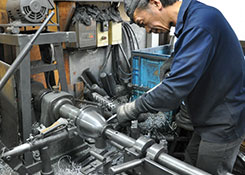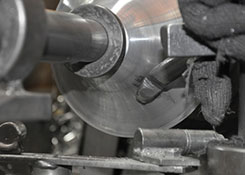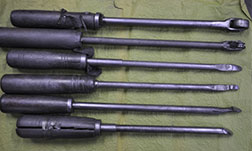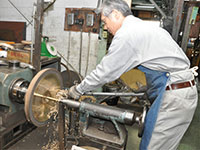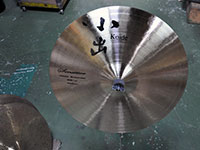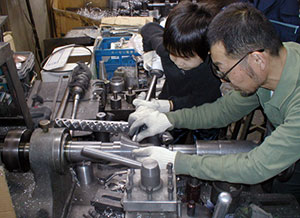Web Japan > Trends in Japan > Tech & Life > Hera-shibori : Metal Spinning
Hera-shibori : Metal Spinning
Art of Metal Sheet Processing

Workmen applying the hera-shibori technique to make a parabolic antenna (photo courtesy of Kitajima Shibori Seisakusho Co.)
From space rocket parts to buckets for daily life, Japan boasts the technology that takes advantage of the manual dexterity of the Japanese people to form iron and other metals into any form. It is called hera-shibori, or metal spinning. It is a metal sheet-processing technique requiring exquisite manual work. Rocket nose cones and parabolic antennas, which we believe are made with precision machinery, are often made by metal spinning. Finished products boast higher degrees of precision than those made by state-of-the-art processing machines when it comes to fine details of processing. Yet, since the work is done by hand, it has the advantage of being suitable for small-lot production.
It is a technique in which only those who are very good at monozukuri, or making things, can excel. This exactly applies to the Japanese. Such a technique is indispensable for the manufacture of precision parts, which does not tolerate any error and which is often subjected to numerous fine adjustments required by the buyer.
Counting on Artisan’s Intuition
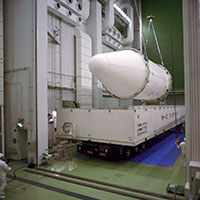
The nose cone of an H-IIA rocket manufactured by using the advanced techniques of hera-shibori [photo courtesy of Japan Aerospace Exploration Agency (JAXA)]
Enlarge photoJapan’s H-IIA rocket is like a solid cluster of precision parts, which are filled with state-of-the-art technology. But its nose cone is made by metal spinning. Since these parts require a high degree of precision while they are not made in large numbers, metal spinning, applied by a workman on one item at a time, is best suited for their production.
Materials subject to metal spinning are iron, copper, aluminum and other metal sheets. An iron hera, or spatula, which has a circular head with a handle about 1.0-1.5 meters long, is applied to the workpiece to form it into shape. The Japanese name for metal spinning, hera-shibori, comes from this tool.
In practice, it works this way. A workpiece, such as an iron sheet, is attached to the top of a metal or wooden pattern, which is rotated at a high speed by a motor. The head of a hera is pressed against the workpiece, and is moved horizontally from the center of rotation. The workpiece then takes the form of the pattern. The principle is the same as pottery making using a potter’s wheel.
It goes without saying that subtle curves and other features require the artisan’s skilled technique. The artisan holds one end of the hera under his arm, holds the head of the hera steady with the other hand and moves it with a fine control of force. Depending on the type of material and the form of a finished product, the head of a hera can take many forms – circular, acute angle, etc. The rotation speed is also variable. To change the angle and force of the hera with instantaneous judgment requires a sixth sense developed by many years of experience.
The hera-shibori technique is used for many purposes in addition to manufacturing rocket parts. It is applied to manufacturing prototypes for the washing tank of semiconductor-manufacturing equipment, the body of a centrifuge, beverage cans, cookware and kettles. Making a large item, such as a parabolic antenna, sometimes requires several artisans working together.
New Applications
Left: A bronze sheet is being processed into a cymbal as it sheds shavings.
Right: A finished cymbal.
Press work, a technique commonly used for processing an item, requires a male pattern and a female pattern, while hera-shibori requires only male patterns. Since it is worked with the hands, it is not suitable for mass production. However, it is suited for large-variety and small-lot production. Metal washbowls, which are not found very often these days, used to be made by hera-shibori.
Some new products that take advantage of these characteristics of hera-shibori are now attracting attention. One is a musical instrument, cymbals. In Osaka, there is Japan’s only maker to use the hera-shibori technique to make cymbals.
 |
A metal vase with beautiful hera-me (streaks) at regular intervals. Enlarge photo |
Cymbals are made of bronze, which is an alloy of copper and tin. It is said that the sound of cymbals varies greatly depending on the ratio of tin content and also the manner and extent of stretching the bronze. Since hera-shibori allows fine tuning by freely forming the bronze, it can draw out from the instrument the “preferred sound” that varies subtly from one genre of music to another, such as rock and jazz. Although the manufacturing process is partially automated, hera-shibori is used to process the bronze surface. Monthly production is limited to about 100 cymbals as they are made by hand.
Metal vases and flowerpots made by hera-shibori are also popular. Working with designers, another company in Osaka is producing a new charm of hera-shibori. Processing by hera-shibori sometimes leaves linear streaks on the metal surface, which is called hera-me, or hera marks. The Osaka company does not erase them. Instead, it has adopted them as a new design. The shading pattern created by the streaks gives warmth to a cold metal surface.
Future Artisans of Hera-shibori
As hera-shibori artisans are aging, some projects are under way to pass the technique to young people. For example, some plants are making elementary school and junior high school students actually experience the technique to foster “future artisans.”
Children are astounded by hera-shibori, which changes a raw material -- a simple iron sheet or plate -- into various shapes. When they actually try it, they struggle as even a minute change in the angle at which the hera touches the material instantly changes the form. Nevertheless, with serious expressions on their faces, they enjoy making an item as they are taught the basics of hera-shibori by workmen.
It is said that about 400 companies in Japan are working with hera-shibori. They are all small enterprises with about 10 employees. However, the hera-shibori technique, indispensable for making metal products in large varieties and small lots, is used in numerous fields as a valuable foundation that supports monozukuri (manufacturing) in Japan.
(January 2013)

